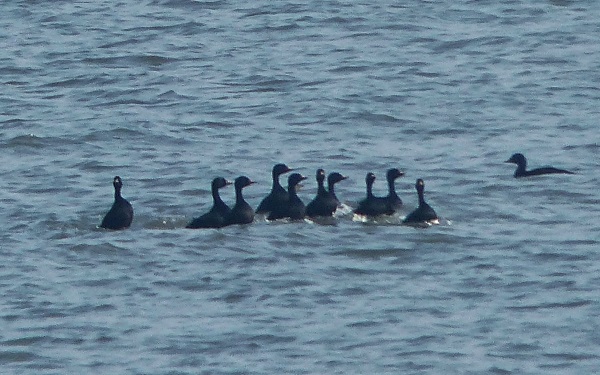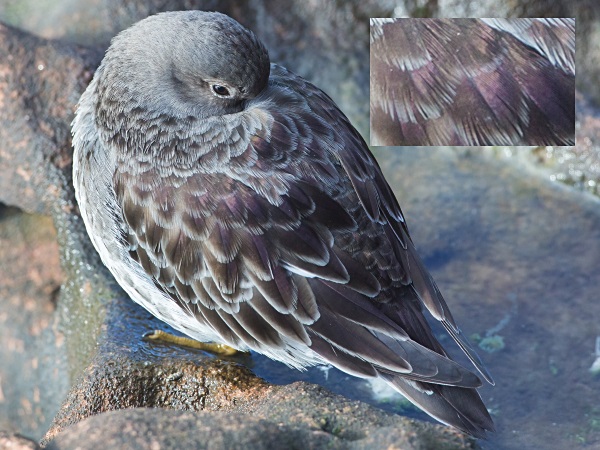Site menu:
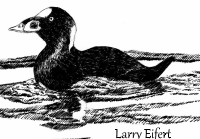
March 2016 Newsletter
Highlights - March 2015 to Feb 2016.
Cheshire & Wirral Bird Report 2014 - Review.
North-east Wales Bird Report 2014 - Review.
Colour Ring Report.
February Bird News.
Forthcoming Events.
Latest Newsletter.
Highlights - March 2015 to Feb 2016.
On the 18th anniversary of the first
newsletter on this website I again publish the highlights of the past
twelve months:
Scoters
The year ended as it began with huge numbers of Common Scoters off North Wirral. The large numbers arrived in mid-March and stayed for a month with max count estimated at 22,500. February saw their return, the highest reasonably accurate count was 36,000 but there was undoubtedly a lot more uncounted. With the March/April 2015 flocks was Cheshire & Wirral's first Surf Scoter and in the end at least nine were thought to be present, plus at least six Velvet Scoters; in February two Surf and two Velvet Scoters were recorded.
Rarities
Apart from the Surf and Velvet Scoters already mentioned the Laughing Gull first seen in February 2015 remained at New Brighton until April.
Glaucous, Caspian and Iceland Gulls were all recorded in March as was an Alpine Swift and three Dotterels were off Meols in May.
June brought a Red-necked Phalarope to Burton, a Serin and Ring-billed Gull were also seen.
July saw a Gull-billed Tern at Burton Mere Wetlands, August a Bee-eater over Shotton and September a Red-backed Shrike at Leasowe.
A Hoopoe was at New Brighton in September and October saw two interesting flyovers - a Pallid Harrier over Hoylake and an Olive-backed Pipit over West Kirby.A Smew was at Shotwick in November with a Lapland Bunting (Little Eye) and Green-winged Teal (Burton) the December highlights.
A Pallas's Warbler at Heswall in January attracted much interest, over-wintering birds of this species being particularly rare.
Two Slavonian Grebes were off north Wirral in February with another in the Dee channel at Connah's Quay. A Glaucous Gull was at Hoylake.
Spring Migration
The dates of the first arrivals were fairly typical for recent years. There were particularly good passages of Ring Ouzels, Common Redstarts and Stonechats.
Sea Birds
Both Common Terns and Little Terns had a good breeding season. Numbers of Sandwich Terns built up to around 1,000 in late summer with a few Arctic Terns and one or two Black Terns spotted. Max summer count of Arctic Skuas was six in August. Calm weather in October resulted in a large count of 967 Great Crested Grebes off north Wirral. 20,000 Herring Gulls were counted on East Hoyle Bank in October.
We waited, and waited, and at last the
gales came in November bringing Leach's Petrels with a max count of 27,
all four species of skuas were also seen. An unusual record
was a Great Skua in late December with one also in January. Single
Little Auks were at both Hoylake and Connah's Quay in January.
Waders
There was a good spring migration of Dunlins with a couple of counts of more than 10,000 in May and good numbers of Sanderling were still coming through in early June. The return migration included 80 Whimbrels at Heswall in July and over 2,500 Black-tailed Godwits in the flooded field at Gilroy Nature Park.
Wildfowl
There was a record number of Teal at Burton Mere Wetlands with 8,000 in November. Good numbers of Pink-footed Geese all winter peaked with an estuary record of 8,900 at the end of February.
Marshland Birds
There was a big influx of Short-eared Owls in September and they seemed to be everywhere, there were several counts of six through the winter and they were reported most days. Several Great White Egrets arrived in the autumn with at least five and reports of two to five were regular through the winter. A Long-eared Owl roosted at Burton Mere Wetlands for several weeks.
Four Marsh Harriers was max count in
August and two to three over-wintered with about the same number of Hen
Harriers. Water Pipits were regular at Neston with a max count of six
in February.
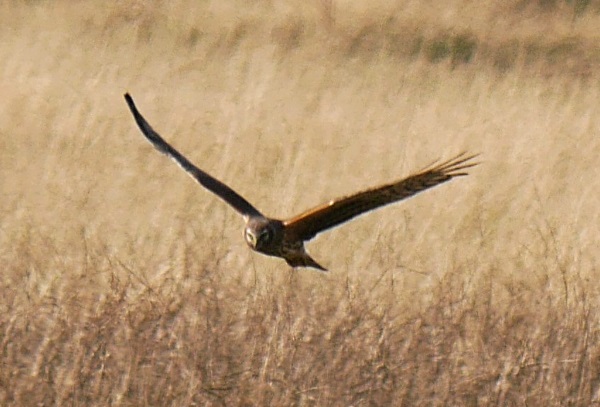
Cheshire and Wirral Bird Report 2014
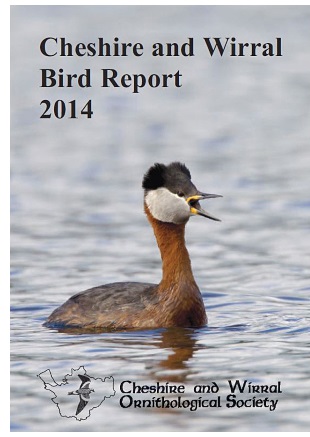 We're delighted to say that the annual
Bird Report for 2014 is now
available (February 2016). This year’s
eyecatching colour front cover is a stunning summer plumaged Red-necked
Grebe, which graced the Weaver Bend at Frodsham for almost two months.
We're delighted to say that the annual
Bird Report for 2014 is now
available (February 2016). This year’s
eyecatching colour front cover is a stunning summer plumaged Red-necked
Grebe, which graced the Weaver Bend at Frodsham for almost two months.
The 176 pages of text include 77 maps, graphs and tables, and 15 beautiful illustrations from three different artists. As usual, the colour map of the county forms the centre spread of the Bird Report. A total of 18 colour photographs, which best capture some of the highlights of the year, are spread over seven full pages.
The Bird Report is full of interesting
articles:
• Local ‘patchers’ turned Red Rocks into a rarity hot-spot, when
Citrine Wagtail, Tawny Pipit and Marsh Warbler were discovered in
2014. Sound recordings are an under-rated aspect of bird
identification, in that the resultant sonograms can often provide a
clear ‘footprint’ as part of the evidence to substantiate a record
which were provided in two out of these three rarities.
• Another article recalls the excitement of finding a male Little
Bunting on Hilbre; the first record for the island, and also the first
‘boat twitch’ to the island as the tide was in!
• Back in 1930s, Spotted Crake used to breed at Burton Mere Wetlands
(known then as Burton bog), but in 2014 breeding was again witnessed by
the sighting of an adult pair and two fluffy black chicks. Hopefully
they will become regular breeders on the reserve.
• Even the smallest of suburban gardens with an established feeding
station can bring hours of fascinating birding with the odd
surprise. This was true in 2014 when a redpoll bonanza
occurred which included Common Redpolls, and more unusually, a Coues’
Arctic Redpoll.
• Last, but not least, there’s a striking account of 27,000 Common
Scoters seen from Hilbre on March 3rd 2014 - one of those great
wildlife spectacles that will always remain in the memory of those who
saw it.
All the ‘regulars’ are there: ‘Weather and Bird Review of the Year’; the full ‘Systematic List of Birds Recorded in Cheshire and Wirral during 2014’, including ‘Category E Species’; ‘Early and Late Dates for Migrants’; ‘Ringing Report’; ‘BBRC and County Rarities Decisions’; ‘Chairman’s Review’; and finally, advice on the Cheshire and Wirral Gazetteer, and the ‘Submission of Records’, including rarities.
Last, but not least, we have again included a ‘Species Index’ at the back to help you quickly look up your favourite species.
The Bird Report is free to Cheshire and
Wirral Ornithological Society members (ordinary membership costs £12),
otherwise it costs £8 + £2 p&p and copies are available from:
David Cogger, 71 Parkgate, Knutsford, Cheshire, WA16 8HF Tel: 01565
228503 Email: davidcogger@cawos.org.
North-East Wales Bird Report 2014
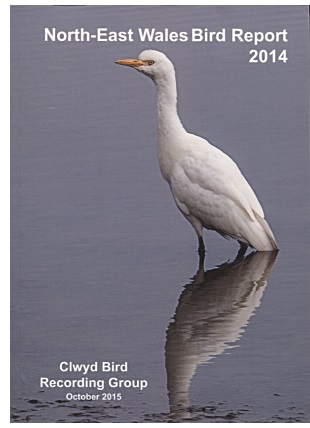 The
North-East Wales Bird Report 2014 has been published and is available
at the RSPB Reserves at Burton Mere Wetlands and Conwy.
It covers the area we used to call Clwyd which is now the vice-counties
of Denbighshire and Flintshire. As far as the Dee Estuary Website is
concerned it includes Gronant to Point of Ayr, down the Welsh coast of
the estuary past Connah's Quay, Shotton and the Shotwick Lake/Fields
area. A large part of the estuary itself is in Wales, of course,
including such sites as West Hoyle Bank (off Hilbre) and White Sands
which is a the large area of marsh on the far side of the
River
Dee channel from Connah's Quay and Flint.
The
North-East Wales Bird Report 2014 has been published and is available
at the RSPB Reserves at Burton Mere Wetlands and Conwy.
It covers the area we used to call Clwyd which is now the vice-counties
of Denbighshire and Flintshire. As far as the Dee Estuary Website is
concerned it includes Gronant to Point of Ayr, down the Welsh coast of
the estuary past Connah's Quay, Shotton and the Shotwick Lake/Fields
area. A large part of the estuary itself is in Wales, of course,
including such sites as West Hoyle Bank (off Hilbre) and White Sands
which is a the large area of marsh on the far side of the
River
Dee channel from Connah's Quay and Flint.
There is the usual comprehensive Systematic List and what I like particularly about this report is that, apart from a handful of the rarer birds, every species has a distribution map so you can see at a glance where the species can be found.
There are no less than 32 superb colour photographs including the Cattle Egret on the front cover. Peter Coffey's article "The status of a local Pied Flycatcher population in Denbighshire" is a fascinating account of his long term study of this species. There are also the regular articles including "First and last dates of selected migrants 2014" and the comprehensive "Ringing Report" which covers 11 pages.
For those that can't make it to Conwy or Burton Mere Wetlands you can obtain a copy by post (£5.00 plus £1.70p&p) - contact the Clwyd Bird Recording Group Bird Recorder/Report Editor for details.
Top of PageColour Ring Report
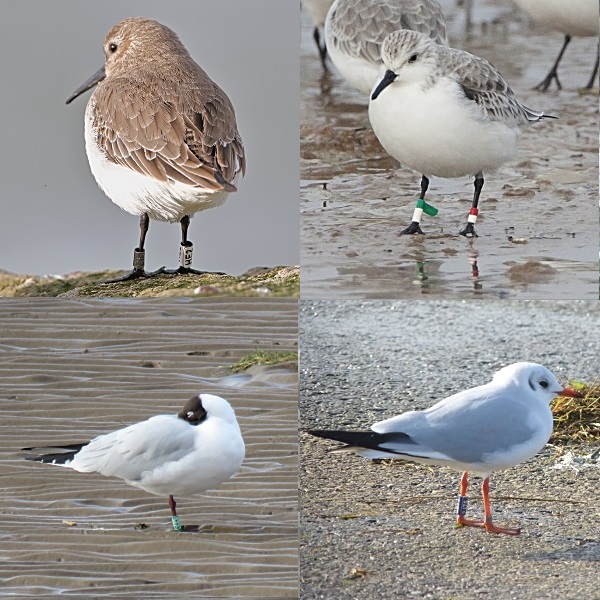
A better month for colour-ringed birds. As
soon as the weather went a bit colder the numbers of waders increased
although much searching through the Knot flocks didn't produce a single
ringed one.
Dunlin
HE2
(black letters on white ring). Ringed on July
29th 2015 at Gdansk, Poland.
Recorded on February 9th 2016 at West Kirby Marine Lake.
One of a total of nine Polish ringed Dunlins we have seen on the Dee
estuary since February 2012.
Sanderling
G4RWWW.
Ringed near Reykjavik, Iceland, on May 14th 2009.
Recorded at Hoylake Shore on February 13th 2016.
Recorded every year in May on a beach near Rekjavik from 2009 to 2015
whilst migrating north to breed in Greenland.
Away from Iceland the only other sites it has been recorded at is
Hoylake, Leasowe, Formby and Ainsdale: it was at Leasowe on January
2010 then 15 times at Hoylake during Autumn and winter from October
2012 through to February 2016. It was at Ainsdale Beach on February 9th
2016.
This is our most regular, and most photographed, Sanderling,
demonstrating just how site faithful they can be.
Black-headed Gulls
2J75 (white letters on blue ring). Ringed in Bowness, Cumbria, on January 3rd 2015.Recorded at West Kirby Marine Lake on January 29th and February 13th, 25th, 26th and 27th 2016.
It was at Bowness in August and October 2015.
J39E (white letters on green ring). Ringed at Oslo, Norway, on April 14th 2015.
Recorded at Hoylake Shore on January 31st and February 13th 2016.
It remained at, or near, the ringing site until late May 2015.
Seen at Hoylake Shore in August and September 2015.
5HP (Black letters on white ring). Ringed at Copenhagen, Denmark, on March 29th 2015.
Recorded at New Brighton on February 15th 2016.
First record after ringing was at New Brighton in July 2015, it was then seen there on November 21st 2015 and twice in December 2015.
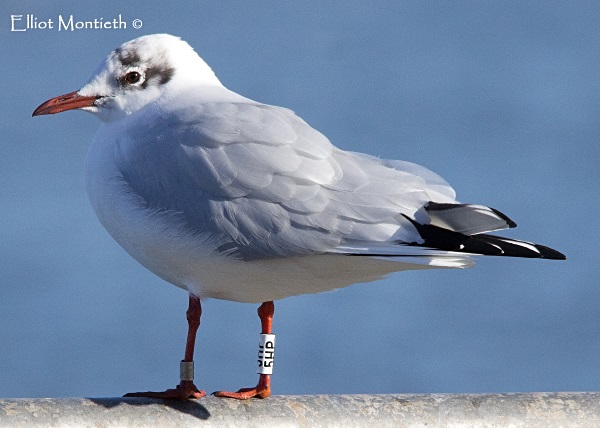
Richard
Smith and Matt Thomas.
Colour-ringed birds were also recorded by Steve Hinde, Steve Williams,
Alan Hitchmough, Karen Leeming, Elliot Monteith, Kenny McKniffe, Tim
Kinch and Colin Schofield.
February Bird News
The huge flocks of Common Scoters off
north Wirral seen over the past two springs arrived early this year,
total numbers were probably over 50,000 but so distant accurate counts
were near impossible; however, Jane Turner did manage a good count on
the 11th with 36,000 in the air - just amazing! The max in 2014 (March)
was 27,000 and in 2015 (March/April) was estimated at 22,500 - see the "HOW
Many Scoters??!!" article. This year's flocks have so far
produced a single Surf Scoter on the 10th with two present on the 27th,
plus a few Velvet Scoters with most records off Wallasey where they
have come reasonably close. Also off north Wirral were 749 Great
Crested Grebes on the 25th and there were three reports of Slavonian
Grebes including two off Wallasey also on the 25th. Gull numbers have
been low but we did have a Glaucous Gull at Hoylake on the 15th.
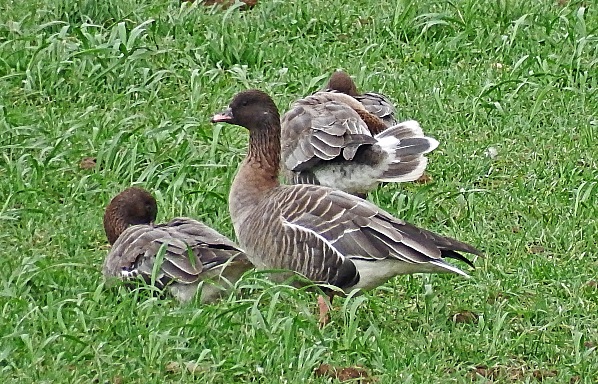
Regular readers of this newsletter will know how Pink-footed Geese
numbers have been increasing over the past few years giving great
pleasure in particular to those that remember their almost total
absence not so many years ago - on the 28th an incredible 8,900 were
present with 400 at Parkgate and the rest on Burton Marsh, an estuary
record.
Purple Sandpipers are normally regarded as rather dumpy grey birds of
interest only because of their comparative scarcity - aren't they? And
I'm sure many have wondered exactly why they are called Purple,
certainly the Collin's Bird Guide makes no mention of any purple in the
plumage. But take a lot at Matt Thomas's remarkable photograph above,
with the sun striking the bird at just the right angle you quite
clearly see the purple sheen of the feathers, quite subtle but quite
wonderful! Max count this month was 12 at New Brighton.
The first Avocet of the spring arrived
at Burton Mere Wetlands on the 12th. We had feared that the high tide
birdwatch at Hoylake, due on the 13th, was going to be a bit of a
non-event due to lack of waders but numbers picked up just in time with
a decent sized flock of several species. The most unexpected sight was
of 15 Whooper Swans just sat on the calm sea at high tide, something
none of us remember happening before - they were a long way out so
identification was difficult but the general consensus was that they
were Whoopers and the two that came closer confirmed this.
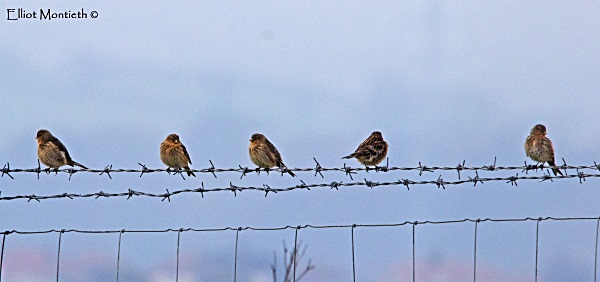
https://elliotsbirdingdiaries.wordpress.com/
There were good numbers of Twite at Connah's Quay with at least 90 this
month (see
Species Spotlight - Twite), confirming the area as one of the
most important over-wintering sites in the country for this species.
Quite a few Siskins passed through
during the month with many on garden feeders.
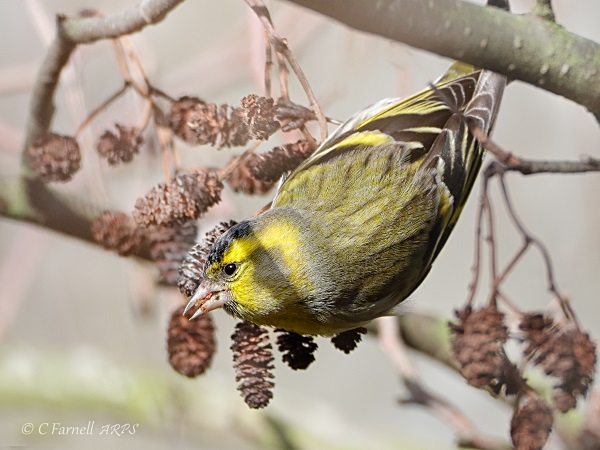 Siskin at Gilroy Nature Reserve, February 7th © Charles
Farnell.
Siskin at Gilroy Nature Reserve, February 7th © Charles
Farnell.
The spring tides gave some good sightings of Short-eared Owls off Heswall with a maximum of six on the 8th. We never see these birds at Heswall during the day time (other than when flushed by high tides) so must assume they fly inland to hunt at night. As usual one or two were regularly seen hunting over Neston and Burton Marshes with one off the Harp Inn giving particularly good views. Between there and Parkgate a total of six Water Pipits were counted on the 27th feeding in the fresh water margins of the marsh, of which there were plenty after all the rain.
The juvenile Great Northern Diver on
West Kirby Marine Lake was last reported on the 10th and last, but not
least, the Pallas's Warbler at Target Road, Heswall, was spotted again
right at the end of the month. No doubt it had been in the area all
along but access in the direction of Sheldrake's is impossible there
and it wouldn't have had to move very far along the thick hedgerow to
disappear. Mis-identified!
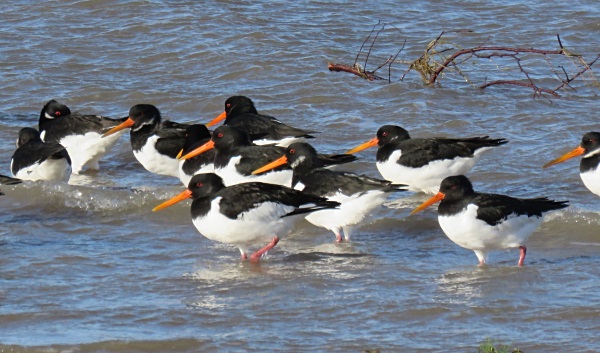
Richard Smith.
What to expect in March
| Species | 2015 | Location (2015) | 2014 | 2013 |
|---|---|---|---|---|
| Sand Martin | 7th March | Flint | 20th March | 28th March |
| White Wagtail | 10th March | Red Rocks | 8th March | 14th March |
| Wheatear | 11th March | Hilbre | 10th March | 17th March |
| Swallow | 20th March | Burton | 19th March | 10th April |
| Willow Warbler | 22nd March | Flint | 12th March | 6th April |
| House Martin | 31st March | Burton | 29th March | 12th April |
| Whitethroat | 12th April | Heswall | 4th April | 15th April |
| Swift | 18th April | Burton | 3rd May | 17th April |
| Cuckoo | 20th April | Burton | 2nd May | 13th April |
There are some big tides due on the 10th and 11th, that's early enough to mean most of the over-wintering marshland birds will still be present and we should get great views of Short-eared Owls, Great White Egrets, Marsh Harriers, Hen Harriers, Water Rails and several thousand Pink-footed Geese.
If we get some calm and clear weather coincident with high tides that will give some spectacular views of the birds on the sea. Hopefully the huge Scoter flocks will come closer as well as the hundreds of Great Crested Grebes and the tens of Red-throated Divers. 'Closer' is a relative term as you will still need a good telescope to see all these. Lookout for the rarities including Surf and Velvet Scoters.
Spring tides are a good time to see Purple Sandpipers at New Brighton, numbers have been fairly low this winter but they often peak this month so maybe we could get as many as 20. Avocets will be moving north and we would expect at least 40 at Burton Mere Wetlands.

Top of Page
Forthcoming Events
March Highest Spring Tides (Liverpool)
Also
see Tides
page.
9th March, 11.11hrs (GMT), 9.9m.
10th March, 11.54hrs (GMT), 10.2m.
11th March, 12.38hrs (GMT), 10.2m.
12th March, 13.21hrs (GMT), 10.0m.
Forthcoming Events
Organised by the Wirral
Ranger Service , Flintshire
Countryside Service and the
RSPB (Dee Estuary):
All these events and walks have bird interest, even those not
advertised specifically for birdwatching. No need to book for these
events unless specified - please check below.
Also see 2015 Events Diary.
1 pm - dusk
Price: Free
Most people have never seen a hen harrier, but once seen it is rarely forgotten. In support of the RSPB's Skydancer project, we are pleased to bring you a series of events to showcase these enigmatic birds of prey which use the marshes of the Dee Estuary as their home for the winter months.
The name "Skydancer" comes from the aerobatic displays that the male birds perform in their courtship ritual on the moors in the spring. Sadly, this has become an increasingly rare sight and they are close to becoming extinct as a breeding bird in England.
This could be the last chance to see Skydancers on the Dee, so come along to Parkgate to find out more about the hen harrier story and what you can do to help save them before it's too late. Look for the RSPB marquee along the main promenade at Parkgate, where friendly staff and volunteers will be on hand with telescopes and binoculars to show you these beautiful, agile birds hunting over the marsh, and coming in to roost there at dusk. Plenty of family activities and other RSPB information will be available.
Car parking is limited on Parkgate promenade, but there is free public parking at the Old Baths car park (CH64 6RN) at the north end of The Parade, and the Wirral Country Park car park on Station Road (CH64 6QJ). There are public toilets at Mostyn Square in the middle of The Parade, and a number of pubs and cafes for refreshments. Wrap up warm, and prepare to be patient as the harriers have a large area of marsh to roam!
For more information on the RSPB's Skydancer project, visit
http://www.rspb.org.uk/skydancer/
Thursday 10th March, Friday 11th March and Saturday 12th March - Parkgate RSPB High Tide Birdwatch.
Start 10.30hrs on 10th, 11.15hrs on 11th and 12 noon on 12th - It is recommended to arrive at least an hour before high tide which is: 11.54hrs on Mar 10th, 10.2m; 12.38hrs on Mar 11th, 10.2m; 13:21hrs on Mar 12th, 10.0m.
The marsh at Parkgate is one of the best wetland habitats in the northwest, and when it is flooded by an incoming Spring high tide, the wildlife which lives here is pushed closer, potentially delivering an awe-inspiring spectacle. Join us at Parkgate's Old Baths car park and the Donkey Stand near Nicholl's ice cream shop, where we'll be set up with marquees and telescopes hoping for the right weather conditions to really push the tide in.
You can expect great views of the large numbers of wintering wildfowl and wading birds shifting around to avoid the rising water, whilst the small mammals living on the marsh are flushed from cover, offering a feeding frenzy for the resident kestrels and hopefully harriers and short-eared owls returning for the winter.
Car parking is limited on Parkgate promenade, but there is free public parking at the Old Baths car park (CH64 6RN) at the north end of The Parade, and the Wirral Country Park car park on Station Road (CH64 6QJ). There are public toilets at Mostyn Square in the middle of The Parade, and a number of pubs and cafes for refreshments.
Additional parking has also kindly been offered at Marsh Nurseries, Boathouse Lane (postcode CH64 6RD).
Please note: the height of the tide can be hugely affected by the weather conditions on the day. In the event of high pressure and calm conditions, the tide will cover much less of the marsh and not reach the sea wall, whilst low pressure and strong Westerly winds will help push the tide in and offer the greatest spectacle. We recommend you check the weather forecast on the day to know exactly what to expect.
Saturday 12th March - Weekend Walkabout: a spring tide alternative view, at Burton Mere Wetlands RSPB.
12 noon start (high tide around 1.20 pm
Price: Free (normal reserve entry charges apply to non-members).
Don't fancy standing on Parkgate promenade for the spring tide spectacle? Then join one of our knowledgeable volunteer wardens for an alternative view. This gentle walk to the end of the Hillfort Trail on Burton Point will offer expansive views as the 10 metre tide floods much of the Dee Estuary's vast saltmarsh, a rare and spectacular occurrence.
Watch flocks of geese, ducks and wading birds shifting around in search of dry ground, and the potential for seeing birds of prey including peregrine and hen harriers is also high.
Afterwards, warm up in the cosy Reception Hide with a hot drink beside the pellet stove
No booking required, just turn up on the day. A reasonable level of fitness and sturdy footwear are required. Ring 0151 353 8478 for further details.
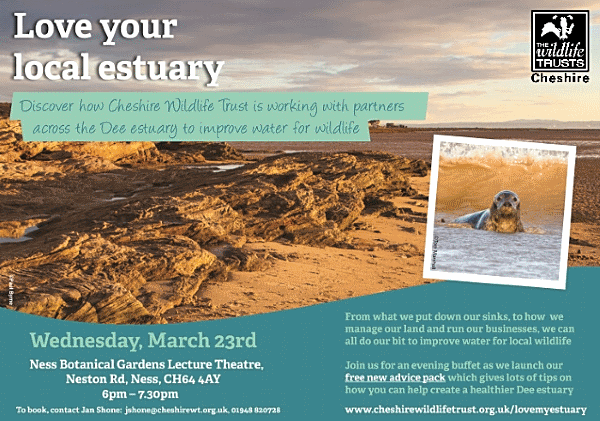
To book contact Jan Shone: jshone@cheshirewt.org.uk, 01948 820728.
Also see http://www.cheshirewildlifetrust.org.uk/lovemyestuary
